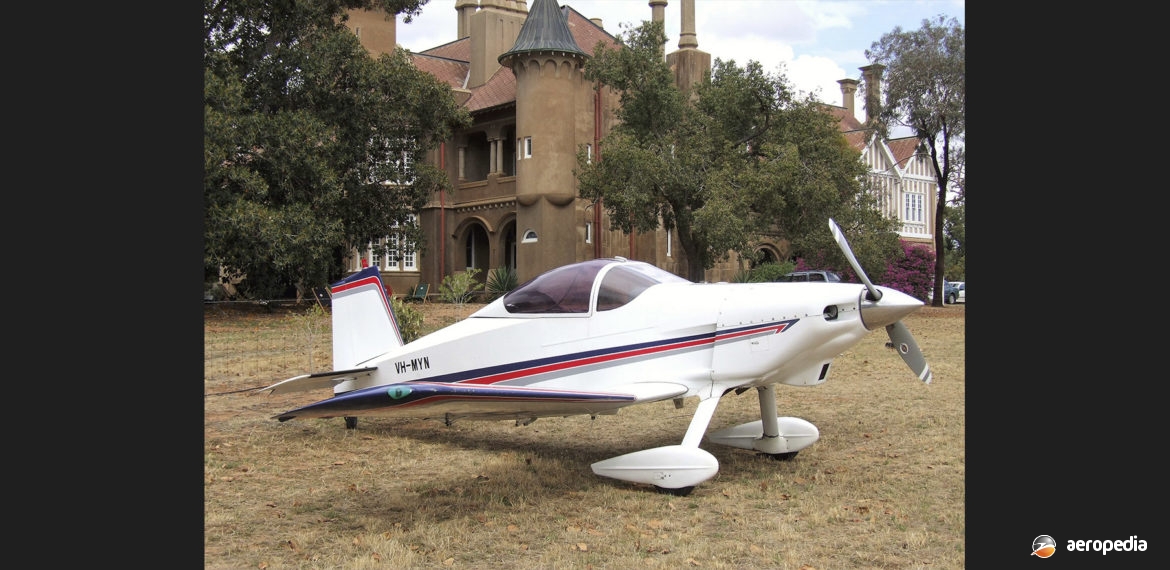Photograph:
Thorp T-18C VH-MYN (c/n N86) at the Iandra ‘Castle’ near Young, NSW in December 2007 (David C Eyre)
Country of origin:
United States of America
Description:
Two-seat light sport monoplane
Power Plant:
One 134 kw (180 hp) Lycoming O-360 four-cylinder horizontally-opposed air-cooled engine
Specifications:
- Wingspan: 6.35 m (20 ft 10 in)
- Length: 5.54 m (18 ft 2 in)
- Height: 1.47 m (4 ft 10 in)
- Wing area: 8 m² (86 sq ft)
- Max speed: 338 km/h (210 mph)
- Max cruising speed: 323 km/h (201 mph)
- Economical cruising speed: 282 km/h (175 mph)
- Stalling speed clean: 109 km/h (68 mph)
- Stalling speed in landing configuration: 95 km/h (59 mph)
- Rate of climb at sea level: 366 m/min (1,200 ft/min)
- Service ceiling: 5,486 m (18,000 ft)
- Range with max fuel: 853 km (530 miles)
- Fuel capacity: 110 litres (24 imp gals)
- Take-off run: 305 m (1,000 ft)
- Landing run: 549 m (1,800 ft)
- Empty weight: 419 kg (923 lb)
- Payload: 181 kg (400 lb)
- Loaded weight: 683 kg (1,506 lb)
History:
Designed by John Thorp in the USA, the T-18 has been one of the most popular homebuilt light aircraft for amateur construction, hundreds having been built around the world. It was designed as an exercise to create a simple all-metal light aircraft utilising the then easily available Lycoming O-290-G engine which provided 93 kw (125 hp), this engine being a ground power unit usually used on generators and converted to O-290-D specifications, fitted with a fixed pitch propeller.
The T-18 was flown for the first time on 12 May 1964. An all-metal structure was used with a non-retractable tailwheel undercarriage, accommodation being provided for two side-by-side under a plexiglass canopy. Space was also incorporated for 36 kg (80 lb) of baggage.
Engines with power ratings ranging from the 101 kw (135 hp) Lycoming O-290 up to 149 kw (200 hp) could be installed. Plans were also available to build the T-18 with folding wings, the latter having a shortened centre-section and lengthened outer wing panels to give a span of 7.67 m (25 ft 2 in). As time has gone by the type has been developed, including the installation of up-rated engines, constant speed propellers and a number of small airframe changes.
The first T-18 Tiger to be completed in Australia was VH-DUD (c/n N16) completed by Mr J Brightwell in 1968, being followed by Mr Peter Hodgens VH-ACE (c/n N15) which was first registered on 17 July 1969, later becoming VH-RGA. Another example became VH-ACB (c/n W143) but the registration was later changed to VH-LPN.
VH-CMC, fitted with a 112 kw (150 hp) Lycoming engine, is probably the most famous of the T-18s in Australia. On 17 October 1972 this machine, flown by its owner/builder, Clive Canning, departed Moorabbin, VIC for an attempt on the around Australia record, returning after 52 hours flying time and after travelling 11,332 km (7,042 miles).
Mr Canning later made a return trip to the United Kingdom in VH-CMC, flying time for the trip being 194 hours 43 mins. Whilst in the United Kingdom he visited a number of air rallies, and wrote and published a successful book on his epic journey. The aircraft was for a period placed on display at Airworld at Wangaratta, VIC before the closure of the museum and sale of its exhibits.
Over 30 examples have been registered in Australia and at least three in New Zealand.
In the United States of America, Donald Taylor from California, circumnavigated the world in a T-18, leaving Oshkosh in Wisconsin on 1 August 1976 in N455DT Victoria and returning 61 days later after 171.5 hours flying time and covering 39,632 km (24,627 miles) at an average speed of 230 km/h (143 mph).
The first Australian example of a T-18C with folding wings was VH-AKO (c/n N84) completed in 1981. This aircraft, together with a number of vintage and amateur-built aircraft, was conveyed in a Qantas Boeing 747 (the Oshkosh Express) to the USA late in 1981, and shown at an Oshkosh meeting of the Experimental Aircraft Association in Wisconsin.
In more recent times a variant of the T-18C became available with a computer-developed LDS-4-212 section wing designed to reduce the stalling speed by 16 km/h (10 mph); and the T-18W, known as the wide-body model, with an increased fuselage width.
The first T-18 completed in New Zealand was ZK-EDF (c/n AACA/43/2), built by Mr G McNicol of Taradale, making its first flight in November 1976.

